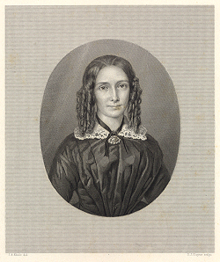Anna Louisa Geertruida Bosboom-Toussaint
Anna Louisa Geertruida Bosboom-Toussaint (born September 16, 1812 in Alkmaar , † April 13, 1886 in The Hague ) was a Dutch writer . Anna Bosboom is one of the most important representatives of romanticism in the Netherlands.
Life
Toussaint was born in the Dutch city of Alkmaar. On April 16, 1833, she completed the basic course with an exam. Soon afterwards she found her calling in the Dutch script. After she was married to the Dutch painter Johannes Bosboom in 1851 , she moved from Alkmaar to The Hague. The “Vrouwen van Nederland” (Women of the Netherlands) dedicated a monument to her on her grave. Her lasting memory is guaranteed by the novels she wrote, which she wrote in half a century of writing.
Anna Bosboom-Toussaint is counted among the most important Dutch artists of the 19th century. After she had aroused great expectations with her novel Almagro (1837), the also acclaimed novel De graaf van Devonshire (1838) followed. Both works were influenced by English Romanticism . In the following period, at the instigation of the editor Potgieter , she shifted her main focus to the history of her fatherland. The result was the novel Het huis Lauernesse (1840), which further improved its reputation, and which was followed by other similar works. Of all these novels, the trilogy De Delftsche wonderdokter (The Miracle Healer of Delft) (1870/1871) deserves special mention as one of Anna Bosboom's main works. As an author, she is also particularly well-known today for her contemporary novel Majoor Frans (1874), which is about a young girl who was raised as a boy by her father.
Works
- Almagro (1837);
- De Graaf van Devonshire, Romantic Episodes uit de jeugd van Elisabeth Tudor (1838);
- Engelschen te Rome, rom. Epis. uit de regering van Paus Sixtus V , 2 volumes (1839);
- Het huis Lauernesse , 2 volumes (1840);
- Een kroon voor Karel den Stoute (1842);
- Promised Verhalen (1843);
- Ximenes-Alba - Orsini. Three novels uit Spanje , 2 volumes (1842);
- Negen short stories - a collection of nine short stories (1846);
- Leycester in Nederland , Trilogy (1846);
- Diana (1847);
- Mejonkvr. de Mauléon (1847);
- Fantasiën in December 1848 (1848);
- Commemorative publication van de inhuldiging des King Willem III in de hoofdstad des rijks (May 12, 1849);
- Het huis Honselaarsdijk in 1631 , historical novella in 2 volumes (1849);
- De vrouwen uit het Leycester's tijdvak trilogy (1849–1850);
- Moedervreugde en moederlijden. Fantasiën (1850);
- Eenige schetsen (1850);
- Media-Noche (around 1851)
- Een tafereel uit den Nijmeegschen vredehandel (1852);
- Don Abbondio II (1853);
- De Alkmaarsche wees some other novellas (1854);
- Gideon Florensz , historical novel, 4 volumes (1854–1855);
- Historical novels (1856);
- Een Leydsch student in 1593 hist. Roman (1858);
- Graaf Pepoli. De roman van een rijk edelman , trilogy (1860);
- De triomf van Pisani (1861);
- De bloemschilderes Maria van Oosterwijk (1862);
- De terugkeer van Golgotha (1862);
- Het laatst bedrijf van een stormachtig leven (1864);
- De verrassing van Hoey in 1595 , 2 volumes (1866);
- Frits Millioen en zijne vrienden. Eene vertelling , 2 volumes (1868);
- De Delftsche wonderdokter , trilogy (1870–1871, 1883);
- Majoor Frans (1877);
- Langs een omweg (1879);
- Raymond de schrijnwerker (1880).
Some of Anna Bosboom's novels were first published in magazines or yearbooks, including the famous De Gid . An anthology with her collected romantic works, novellas and short stories was published in The Hague in 1884.
Web links
- Literature by and about Anna Louisa Geertruida Bosboom-Toussaint in the catalog of the German National Library
| personal data | |
|---|---|
| SURNAME | Bosboom-Toussaint, Anna Louisa Geertruida |
| BRIEF DESCRIPTION | Dutch writer |
| DATE OF BIRTH | September 16, 1812 |
| PLACE OF BIRTH | Alkmaar |
| DATE OF DEATH | April 13, 1886 |
| Place of death | The hague |
